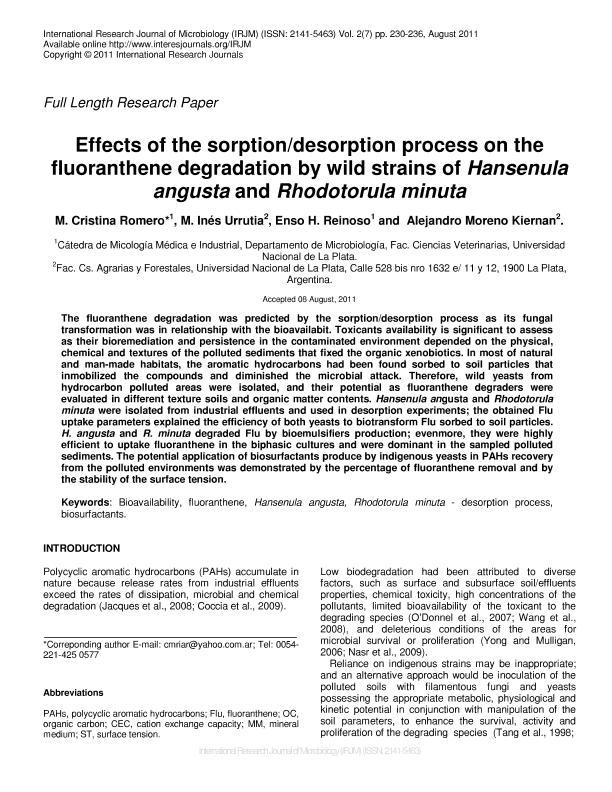Mostrar el registro sencillo del ítem
dc.contributor.author
Romero, Maria Cristina

dc.contributor.author
Urrutia, María Inés

dc.contributor.author
Reinoso, Enso H.
dc.contributor.author
Moreno Kiernan, Alejandro Ricardo

dc.date.available
2020-04-17T13:33:29Z
dc.date.issued
2011-08
dc.identifier.citation
Romero, Maria Cristina; Urrutia, María Inés; Reinoso, Enso H.; Moreno Kiernan, Alejandro Ricardo; Effects of the sorption/desorption process on the fluoranthene degradation by wild strains of Hansenula angusta and Rhodotorula minuta; International Research Journals; International Research Journal of Microbiology; 2; 7; 8-2011; 230-236
dc.identifier.issn
2141-5463
dc.identifier.uri
http://hdl.handle.net/11336/102852
dc.description.abstract
The fluoranthene degradation was predicted by the sorption/desorption process as its fungal transformation was in relationship with the bioavailabit. Toxicants availability is significant to assess as their bioremediation and persistence in the contaminated environment depended on the physical, chemical and textures of the polluted sediments that fixed the organic xenobiotics. In most of natural and man-made habitats, the aromatic hydrocarbons had been found sorbed to soil particles that inmobilized the compounds and diminished the microbial attack. Therefore, wild yeasts from hydrocarbon polluted areas were isolated, and their potential as fluoranthene degraders were evaluated in different texture soils and organic matter contents. Hansenula angusta and Rhodotorula minuta were isolated from industrial effluents and used in desorption experiments; the obtained Flu uptake parameters explained the efficiency of both yeasts to biotransform Flu sorbed to soil particles. H. angusta and R. minuta degraded Flu by bioemulsifiers production; evenmore, they were highly efficient to uptake fluoranthene in the biphasic cultures and were dominant in the sampled polluted sediments. The potential application of biosurfactants produce by indigenous yeasts in PAHs recovery from the polluted environments was demonstrated by the percentage of fluoranthene removal and by the stability of the surface tension.
dc.format
application/pdf
dc.language.iso
eng
dc.publisher
International Research Journals
dc.rights
info:eu-repo/semantics/openAccess
dc.rights.uri
https://creativecommons.org/licenses/by-nc-sa/2.5/ar/
dc.subject
BIOAVAILABILITY
dc.subject
FLURANTHENE
dc.subject
HANSENULA ANGUSTA
dc.subject
RHODOTORULA MINUTA
dc.subject
DESORPTION PROCESS
dc.subject
BIOSURFACTANTS
dc.subject.classification
Biología Celular, Microbiología

dc.subject.classification
Ciencias Biológicas

dc.subject.classification
CIENCIAS NATURALES Y EXACTAS

dc.title
Effects of the sorption/desorption process on the fluoranthene degradation by wild strains of Hansenula angusta and Rhodotorula minuta
dc.type
info:eu-repo/semantics/article
dc.type
info:ar-repo/semantics/artículo
dc.type
info:eu-repo/semantics/publishedVersion
dc.date.updated
2020-04-02T14:04:20Z
dc.journal.volume
2
dc.journal.number
7
dc.journal.pagination
230-236
dc.journal.pais
Estados Unidos

dc.journal.ciudad
Nueva Jersey
dc.description.fil
Fil: Romero, Maria Cristina. Consejo Nacional de Investigaciones Científicas y Técnicas. Centro Científico Tecnológico Conicet - La Plata; Argentina. Universidad Nacional de La Plata. Facultad de Ciencias Veterinarias. Departamento de Microbiología; Argentina
dc.description.fil
Fil: Urrutia, María Inés. Universidad Nacional de La Plata. Facultad de Ciencias Agrarias y Forestales; Argentina
dc.description.fil
Fil: Reinoso, Enso H.. Universidad Nacional de La Plata. Facultad de Ciencias Veterinarias. Departamento de Microbiología; Argentina
dc.description.fil
Fil: Moreno Kiernan, Alejandro Ricardo. Universidad Nacional de La Plata. Facultad de Ciencias Agrarias y Forestales; Argentina
dc.journal.title
International Research Journal of Microbiology
dc.relation.alternativeid
info:eu-repo/semantics/altIdentifier/url/https://www.interesjournals.org/abstract/effects-of-the-sorptiondesorption-process-on-the-fluoranthene-degradation-by-wild-strains-of-hansenula-angusta-and-rhodo-17220.html
Archivos asociados
